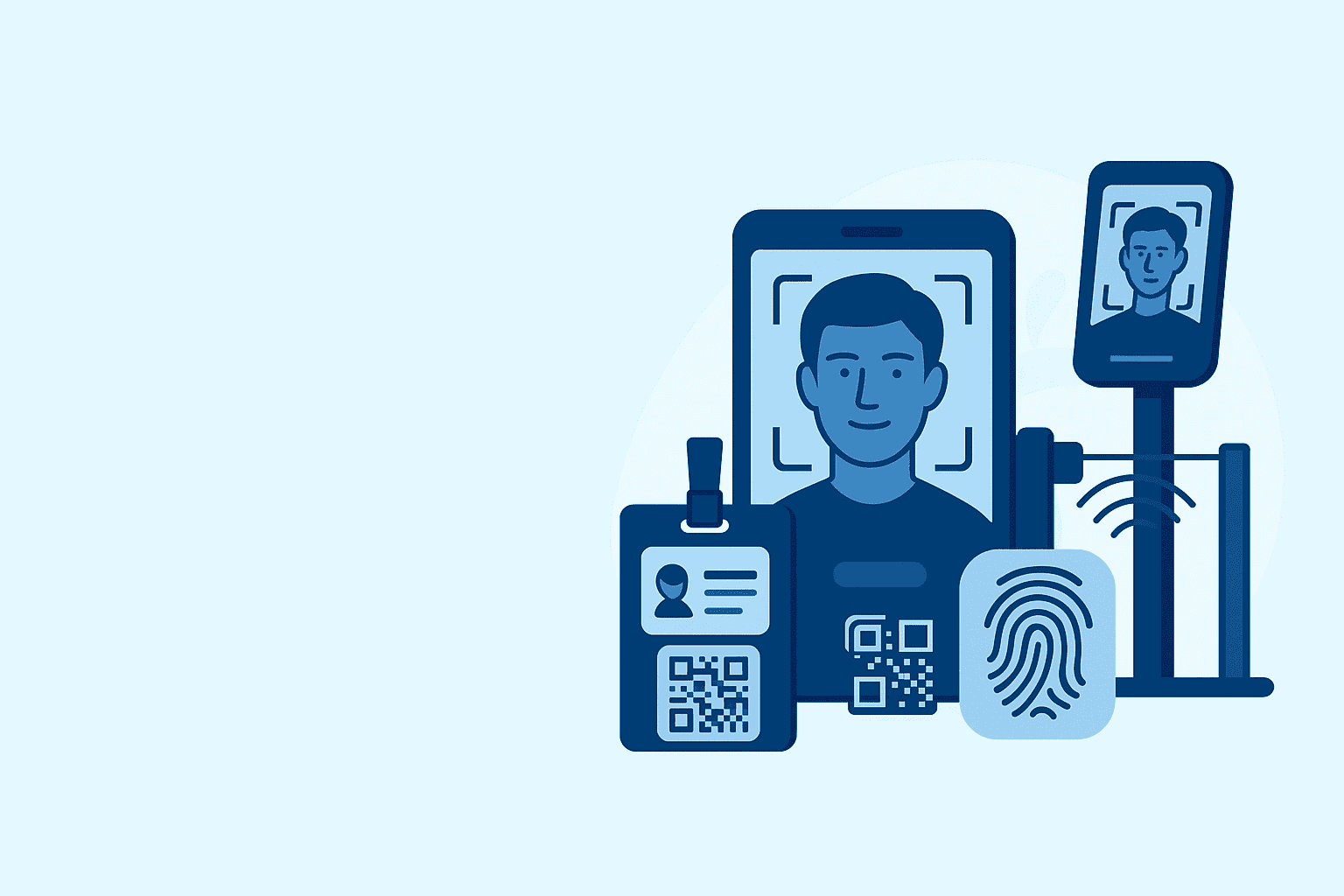The events industry is experiencing an unprecedented technological transformation, especially regarding event access control and accreditation systems. Attendee expectations have evolved toward more fluid and secure experiences, while organizers seek solutions that combine operational efficiency with robust security measures.
Importance of digital accreditation for participant security and experience
Event attendee accreditation has ceased to be a simple administrative process to become a strategic element that defines the first impression and sets the tone for the entire event experience. In a world where security is paramount and user experience determines success, digital accreditation systems have become indispensable.
Today’s participants expect access processes that are as fluid as those they experience at international airports or cutting-edge corporate buildings. This expectation is not just about convenience, but also about the perception of professionalism and confidence in implemented security measures.
Data and statistics on access control evolution
According to recent industry studies, 73% of event organizers have implemented some type of digital event accreditation in the last three years. This massive adoption has accelerated significantly, with a 340% growth in biometric technology implementation for large-scale corporate events.
User satisfaction metrics show that events with advanced digital accreditation systems register 85% fewer complaints related to entry processes, and a 60% reduction in access times compared to traditional methods. This data demonstrates that investment in accreditation technology not only improves operability but also directly impacts event quality perception.
Evolution of event accreditation systems
From manual lists to digital solutions and biometrics
The evolution of event access control has followed a fascinating trajectory from paper lists to cutting-edge biometric systems. In the first phase, printed lists and physical accreditations predominated, a system that, although familiar, was prone to human errors and long waiting times.
The second generation introduced barcodes and basic readers, significantly improving processing speed. The third generation incorporated RFID and NFC technologies, enabling almost instantaneous access and the possibility of integrating multiple functionalities into a single device.
Currently, we find ourselves in the fourth generation, characterized by digital event accreditation that integrates artificial intelligence, biometric recognition, and adaptive systems that learn from attendee behavior patterns to continuously optimize the access experience.
What can we expect in the coming years?
The next five years promise to completely revolutionize the event accreditation landscape. Emerging trends point toward completely autonomous systems that require no human intervention, using combinations of facial recognition, predictive behavior analysis, and multiple biometric validation.
Integration with augmented reality technologies will enable personalized welcome experiences, where attendees can receive contextual information about the event, suggested networking, and optimized routes as soon as they complete their accreditation process. Additionally, blockchain implementation for identity verification promises to completely eliminate the possibility of accreditation fraud.
Emerging technologies in accreditation and access control
Use of biometrics and facial recognition
Practical applications and benefits for events
Biometrics represents the most advanced frontier in event attendee accreditation, offering previously unattainable levels of security and convenience. Facial recognition, in particular, has proven especially effective at large-scale events, where it can process multiple individuals simultaneously without requiring physical interaction with devices.
Practical applications include instant identity verification, detection of individuals on security watch lists, and automatic experience personalization based on attendee profile. The benefits are multifaceted: complete elimination of waiting lines, drastic reduction of personnel needed for access control, and ability to generate detailed analytics on attendance patterns and behavior.
Biometric technology also enables implementation of differentiated access zones without need for additional physical credentials, facilitating management of complex events with multiple access levels and participant types.
Integration of artificial intelligence in access control
How AI can optimize security and entry flow
Artificial intelligence is transforming event access control from a reactive to a predictive and adaptive process. AI systems can analyze historical arrival patterns, predict attendance peaks, and automatically adjust access point configuration to optimize people flow.
Machine learning algorithms can identify anomalous behaviors in real time, alerting security personnel to potentially problematic situations before they materialize. This predictive capability is especially valuable at high-security events where prevention is crucial.
Additionally, AI can personalize the accreditation experience based on attendee profile, declared preferences, and behavior at previous events, creating a unique and memorable welcome process for each participant.
Security and data privacy in digital accreditation
Regulations and standards on data protection
Implementation of digital event accreditation must navigate a complex regulatory landscape that includes GDPR in Europe, CCPA in California, and various local data protection legislations. Organizers must ensure their systems comply with the highest data privacy and security standards.
Regulations require explicit consent for collection and processing of biometric data, implementation of robust security measures to prevent data breaches, and clear processes for deletion of personal information once the event concludes. Compliance is not only a legal obligation but also a crucial factor in maintaining attendee trust.
Organizers must implement clear data retention policies, end-to-end encryption systems, and regular security audits to ensure their accreditation systems comply with all applicable regulations.
Challenges in implementing advanced technologies
Main challenges include resistance from some attendees to share biometric data, technical complexity of integrating multiple security systems, and significant costs associated with implementing cutting-edge technologies. Additionally, there’s the challenge of maintaining backup systems for cases where primary technology might fail.
Staff training is another critical aspect, as advanced systems require specialized knowledge for operation and maintenance. Organizers must also consider privacy implications and ensure they have clear protocols for handling sensitive data ethically and legally.
Hybrid and digital events: the future of accreditation
How to ensure smooth access at hybrid and digital events
Hybrid events present unique challenges for event attendee accreditation, requiring systems that can seamlessly handle both in-person and virtual participants. The key lies in developing unified platforms that provide equivalent experiences regardless of participation mode.
For in-person participants, this means accreditation systems that integrate perfectly with the event’s digital platforms, enabling access to both physical spaces and exclusive digital content. For virtual participants, it requires robust identity verification processes that prevent unauthorized access while maintaining ease of use.
Real-time synchronization between physical and digital components is essential, ensuring that interactions, networking, and content access are fluid regardless of the participation modality chosen by each attendee.
Adaptive accreditation systems
Adaptive systems represent the next evolution in event access control, using artificial intelligence to automatically adjust accreditation processes based on real-time event conditions. These systems can modify access flows, adjust security levels, and personalize experience based on factors like crowd density, weather conditions, or security alerts.
Adaptability also extends to the ability to handle last-minute changes in event configuration, such as adding new sessions, changes in space layout, or modifications to access permissions for different attendee categories.
How to choose the best accreditation system for your event?
Essential criteria in technology selection
Selecting the appropriate digital event accreditation system requires careful evaluation of multiple factors. Event size and type determines the scale and complexity required of the system. Intimate events may benefit from simple QR-based solutions, while international conferences may require advanced biometric systems.
Available budget must be balanced with desired features, considering not only initial implementation costs but also ongoing operational expenses, maintenance, and system updates. Venue technical infrastructure is another crucial factor, as some systems require high-speed connectivity and specific hardware configurations.
The organizing team’s previous experience with similar technologies influences the system complexity they can handle effectively. It’s preferable to choose a solution the team can operate confidently rather than advanced technology that might result in operational problems.
Use cases and recommendations
For corporate events of 500-2000 attendees, RFID-based systems with mobile integration offer the best balance between functionality and cost-effectiveness. For academic conferences, QR codes with online pre-registration provide sufficient simplicity and efficiency.
High-security events like government summits or financial conferences require biometric systems with multiple validation and integration with security databases. Festivals and outdoor events benefit from ruggedized systems that can operate in adverse weather conditions.
Hybrid events need platforms that seamlessly integrate physical and digital components, with live streaming capabilities and virtual networking integrated into the accreditation process.
Conclusion and predictions for the future
Checklist: How to adapt your event to new accreditation trends
Needs assessment:
- Analyze attendee demographic profile and their comfort level with technology
- Determine specific security requirements for the event
- Evaluate available technical infrastructure at the venue
- Establish available budget for accreditation technology
Technology selection:
- Consider system scalability for future events
- Verify compatibility with existing event management systems
- Evaluate reporting and analytics capabilities
- Ensure compliance with applicable data protection regulations
Implementation and testing:
- Conduct exhaustive testing under conditions similar to the actual event
- Train staff in using the selected system
- Develop contingency protocols for technical failures
- Establish clear communication channels with attendees about the new system
Main recommendations for event organizers
The future of event access control will be defined by the convergence of multiple emerging technologies. Organizers who invest in adaptive and scalable systems will be better positioned to leverage future innovations without requiring complete infrastructure replacements.
The key to success lies in finding the optimal balance between technological sophistication and practical usability. It’s not about implementing the most advanced technology available, but selecting solutions that best serve the event’s specific objectives and attendee expectations.
Event attendee accreditation will continue evolving toward more intelligent, secure, and user-friendly systems. Organizers who adopt a continuous improvement mindset and stay informed about emerging trends will be better equipped to deliver exceptional experiences that exceed participant expectations and establish new industry standards.








